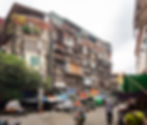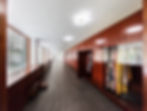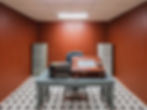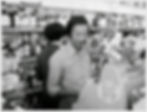Exploring the heart of Vietnamese Modernism
- Darren Bradley
- Sep 5, 2018
- 8 min read
Updated: Sep 6, 2018

There are plenty of reasons to visit Vietnam. The wonderful food… the warm and welcoming people… the spectacular scenery… All of those are absolutely true. When I told people that I really wanted to go for the architecture, I got a lot of strange looks. But Vietnam is really the perfect spot for a fan of mid-century modern architecture. The country saw most of its development from about 1949 to 1975, and then very little after that - until it finally opened again economically to the rest of the world in the mid-1990s. When you think about it, Palm Springs followed a similar economic development trajectory - albeit without the war or communist take-over…

So before visiting, I had high hopes of finding some great post-war Modernist architecture there… preserved in amber, if you will, and free from redevelopment or bad renovation decisions. That wasn't really the case. The result was more of a mixed bag, to be honest. The lack of redevelopment did not prevent much of the architecture from being modified over time beyond recognition.

And in some places like Da Nang or Saigon, redevelopment is in full swing and buildings are getting demolished and rebuilt at a dizzying rate. But there is one stand-out example of Modernist architecture in the country that is in impeccable condition, preserved like a time-capsule: the Independence Palace in Saigon.

The Independence Palace (Dinh độc lập in Vietnamese) was the official residence and offices of the President of the Republic of Vietnam (South Vietnam). It was essentially the South Vietnamese “White House” up until the day a Viet Cong tank crashed through the gates on 30 April 1975, signaling the end of the regime and the re-unification of the country under North Vietnamese communist rule. Since the capital of North Vietnam was Hanoi, that became the capital of the new, reunified country. The Independence Palace was closed and left as it was found, for the most part. Saigon lost its status as a capital city, and gained instead a new name: Ho Chi Minh City (although most Vietnamese still just call it Saigon).

The Independence Palace is a Modernist building that was designed in 1962 by Vietnam’s most famous and celebrated architect, Ngo Viet Thu, and finally completed in 1966. It was designed to replace the old Presidential palace on the same location. The building is sited pretty much in the same spot and orientation as the previous Norodom Palace - only larger. But rather than a French Colonial style (which is to this day the preferred style of most Vietnamese, by the way…), this palace was done in a New Classical Modernist style, blended with a heavy Vietnamese influence.


That previous building, called Norodom Palace (oddly, after the name of the then King of Cambodia), was bombed in 1962 by several South Vietnamese Air Force pilots who were trying to kill the President of the country, Ngo Dinh Diem. Diem survived the attempt, but the building didn’t fare so well. It was decided to raze the building and design a new one from scratch.

Ngo Viet Thu was Vietnam’s most celebrated architect, so it was no surprise that he got the prestigious commission to design the country's new Presidential Palace.

Thu had studied architecture first in Da Lat (a city in the central highlands of Vietnam, known for its French colonial architecture), and then at the École des Beaux Arts in Paris, where he was the first Asian to win the prestigious Grand Prix de Rome architecture prize in 1955.

In addition to the Independence Palace, he designed many of Vietnam’s most iconic Modernist landmarks, including this Catholic Cathedral and the university in his home town of Hué.



While then-President Diem had commissioned the building following the bombing by his own air force in 1962, he never lived to see its completion. He and his younger brother were killed the following year in another, successful coup. One of the leaders of that coup, a South Vietnamese general named Nguyen Van Thieu, would eventually become President of South Vietnam, himself, and would be the only person (with his family) to ever reside in the Independence Palace. Thieu would live there from 1967 until about a week before the Fall of Saigon in April of 1975.

The palace that Ngo Viet Thu designed is a beautiful example of Modernist architecture, adapted to local Vietnamese climate, customs, and design vernacular. After the fall of Saigon, the palace was renamed “Reunification Palace”, but the sign out front at the visitors’ center still refers to it as Independence Palace, as do most of the locals.

What’s extraordinary about the place - besides the amazing architecture - is that all of the decor, furnishings, and even many of the clothes and personal belongings are still there, on display in the building. It’s easy to imagine what it was like back in the late 60s and early 70s because it simply hasn’t changed a bit. It’s extraordinary. But enough talking about it, here’s a quick tour:

Probably the most distinguishing characteristic of the building are the concrete screens found throughout the second and third floors of the building, on all sides. These are meant to represent bamboo. Here’s a hand-written note where Ngo Viet Thu discusses the idea when he first came up with it, and explains (in French) how he believes it will be both functional and beautiful.

The architect also supposedly incorporated numerous Chinese characters into the design, which was supposed to bring luck.

Apparently, it didn’t work…

As you approach the building from the front, you see that the largest ceremonial rooms are on the main floor, right next to the entrance. Makes sense. On the left as you enter is the Banquet Room.

In addition to being an architect, Ngo Viet Thu was also an accomplished painter. He painted the painting at the opposite end of the room, as a gift to the country upon completion of the building.

On the right is the Cabinet Room...

Straight ahead is the ceremonial staircase (which nobody is allowed to use, apparently). Behind that is a large conference room or ballroom that can accommodate hundreds of guests.

Up a level, there are more ceremonial rooms, albeit a bit more intimate in scale.


There are also a few offices on the second floor, intended for actual work, such as running a war and managing a country.


From the second floor, you can also access the rear living quarters from the second and third levels. I’m guessing that the architect originally intended this to be a self-contained living quarters for the President and his family. It’s essentially a two-level house around a courtyard with a fountain and garden, which is a Modernist interpretation of a traditional Vietnamese home. The family dining area and kitchen are here, and bedrooms and smaller living areas arranged around the courtyard.

But curiously, Thieu’s actual bedroom and personal living quarters are in a different wing of the building, in the front where most of the offices are located.




I couldn’t find much history about this building itself, but I’d bet money that at some point, Thieu decided that he wanted his bedroom in a larger room at the front of the building.
The top floor is mostly reserved for personal living quarters.





The third floor also has direct access to the helipad, upon which sits a South Vietnamese UH-1 helicopter.


There is also a large, rooftop terrace with a bar and entertainment area. The architect had originally intended this as a quiet space for meditation, but Thieu turned it into a party room. I didn't photograph this space because there were too many people up there. But here are the stairs that lead to it.

One of the most fascinating parts of the building are the offices in the bunker underneath the palace.




There are countless rooms here, filled with old phones, radio sets, encrypting and decrypting machines, maps, barracks, and living quarters for the President.
One can easily imagine the dozens of military officers, soldiers, and advisors who spent their days and nights in this rabbit warren trying to manage the war raging outside. There are apparently multiple levels in the bunker, but the public only has access to one of them, and part of another.
There are also escape tunnels there, leading to various other safe houses throughout the city. Apparently, one even leads to a house in the Saigon Zoo. That’s not just paranoia, though. President Diem used tunnels underneath a different palace to escape the coup attempt in 1963, when rebels thought they had him surrounded (he was subsequently captured later).
One of the more interesting rooms in the building (to me, at least) was the office of the Vice-President, Nguyen Cao Ky. That’s because it has more personal effects than any of the other rooms in the palace, and literally looks as if Ky had just stepped out for a cigarette and would be right back. Actually no, he would have smoked right at his desk, so maybe we went to lunch or something, instead. Anyway, it’s fascinating to see. Also, to most Americans these days, the name Nguyen Cao Ky probably means nothing.

But Ky was actually also once the Prime Minister of Vietnam, and ruled the country with an iron fist. He even made the cover of Time Magazine once. The guy was a real character, like something out of a movie. He had been a pilot and rose up to be head of the country’s air force. He was a playboy, and a cowboy. He wore tailored black flight suits with a trademark lavender-colored silk scarf around his neck.

His second wife, who had been a flight attendant on the national airline, often toured the country with him wearing a matching flight suit.


As head of the country’s air force, Ky participated in the coup that overthrew Diem, which catapulted him to power. Between the first coup in 1963 that overthrew and killed Diem and the final elections in 1967, there were actually multiple additional coups and attempted coups. Ky was behind most of them, and also was often the reason when one of them didn’t work. His favorite tactic was to order several military jets to fly over Saigon and then threaten to bomb something until he got his way. He usually did.

Most people figured Ky would become President but he agreed to step aside in favor of his bitter rival, Thieu, and become the Vice-President, instead. The two hated each other. He only did this because he was assured that he would still be running things behind the scenes, as head of a secret military council. But Thieu out-maneuvered him and in the end, his power waned as Vice President. He withdrew from politics in 1971, once it was clear that he could not win in the new elections against Thieu. When Saigon fell in 1975, Ky was still in Vietnam. He narrowly escaped by commandeering a helicopter and flying himself and his family out to a US aircraft carrier awaiting offshore.
As an epilogue, Nguyen Ky Cao settled in Norwalk, CA near Disneyland and ran a liquor store there for years with wife #3.

Anyway, I know this isn’t about Vietnam War history, but this stuff is too fun not to mention. I like to know about the context of these places, and the people who inhabited them. It’s essential to truly understand and appreciate a space, I think. In fact, one of the reasons I love architecture is because of the stories these buildings tell, like this one. Architecture and design are more than just a collection of lines, shapes, and plumbing fixtures. They are living, breathing entities with stories to tell. When you go to Vietnam, go to the Independence Palace. Go for the beautiful design. But also take the time to learn the stories.
